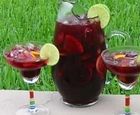|
Spanish Beverage Fruited Wine We have 2 versions of this classsic Spanish fruited wine, one carbonated and one not.
In a large pitcher, combine first 6 ingredients (excpet for carbonated beverage). Refrigerate 4 hours or, even better, overnight. To serve, pour a wine glass 1/2 full of wine/rum mixture and some of the marinated fruit. Top with carbonated beverage. Sangria (Non-Carbonated) Combine all ingredients in a large pitcher and refrigerate for 4 hours. Pour into wine glasses and spoon in slices of fruit. |
Tips & Glossary Tapas are a cultural phenonemon in Spain (and now the world). Spaniards eat dinner quite late, so these small plates of food, served in local bars and taverns, fill the gap between lunch and dinner. Families and friends circulate between tapas bars to socialize and taste these delicious treats. When entertaining Spanish-style, do as the Spaniards do—load up your table with small plates of savory tapas. We’ve included plenty of recipes to help you out. Chili Peppers: any small, hot pepper (as opposed to larger, milder bell peppers). Spain’s habanero is the hottest pepper known, while the piquillo (pee-kee-yo) is intensely sweet. Serranos, originally from Mexico, are also used in Spanish cooking. Crabmeat: sweet, nutty-flavored meat from the body, legs or claws of numerous varieties of crab. Most prized is jumbo lump from the hind leg. For crab dips and fillings, use regular lump, or finback from the body. Buy it fresh if you can. Empanadillas: (em-pan-a- dee-yas), any raw or cooked filling wrapped in a dough and baked in the oven or over an open fire; a culinary treat that dates back to at least medieval times. Mussels: buy only mussels that are tightly closed, never open, chipped or broken. When you get them home, unwrap them so they can breathe and keep them cool before you use them. You don’t want them to die before cooking. Pinchos: (Pinxtos) Basque-style tapas, served on bread slices, with a toothpick (or "spike"–pinchos in Spanish) to hold the topping in place. Queso: cheese! Manchego is Spain’s most famous cheese, a semi-soft sheep’s milk cheese from La Mancha region. Delicious served as tapas: thinly sliced and topped with a slice of quince paste, like cranberry jelly. Roasted peppers: buy or make your own: place peppers under a broiler, or hold over a gas flame, till skin chars and blisters. Place in a closed paper bag for 15-20 minutes (to steam them). When cool enough to handle, the skins will slip off under running water. Saffron: the most expensive spice in the world, from the crocus plant cultivated in Iran and Spain. Along with its unusual taste, it adds a deep rich yellow color to food. Use a strand or two at a time and soak in warm water before using. Serrano ham: “mountain” ham; dry-cured Spanish ham, served raw in paper-thin slices. It’s similar to Italian Prosciutto.
|
Site by BOOM
![]()
LitLovers © 2024

